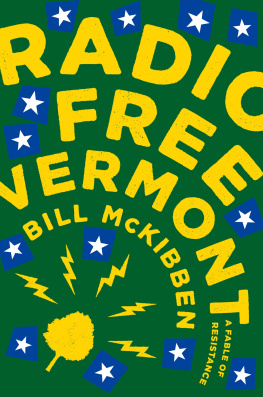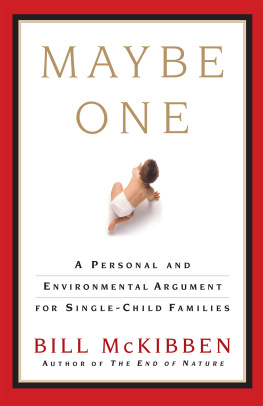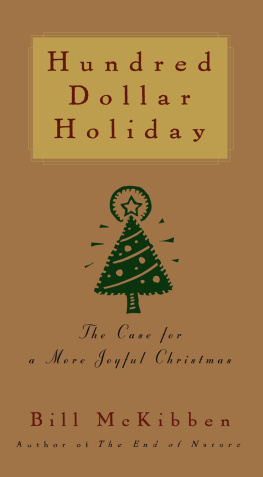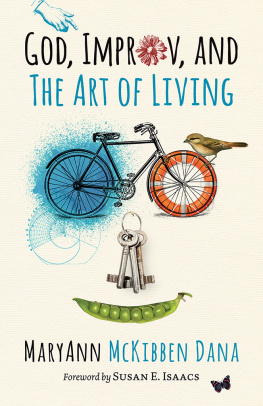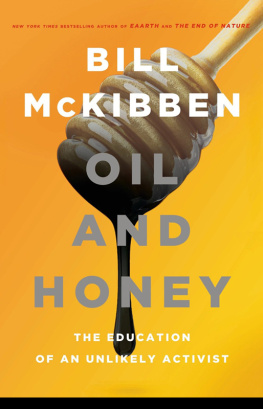Contents
Guide
Pagebreaks of the print version

The author and publisher have provided this e-book to you for your personal use only. You may not make this e-book publicly available in any way. Copyright infringement is against the law. If you believe the copy of this e-book you are reading infringes on the authors copyright, please notify the publisher at: us.macmillanusa.com/piracy.
For Gordon McKibben (19301999) and for Peggy McKibben
In my tenth year, in 1970, my familymy mom, my dad, my seven-year-old brother, and Imoved into the American suburbs. More precisely, we moved to the town of Lexington, Massachusetts, a community of thirty thousand people which sat a dozen miles outside Boston. Our home, which cost $30,000, was like a childs drawing of a suburban home: a square block with a door and a window on the ground floor and two windows on the story above, one looking out from my bedroom and the other from Toms. A single big maple spread its branches over the front lawn and the driveway, dropping leaves on the maroon Plymouth that carried my father on his daily commute. We were as statistically average as it was possible to be, a near-perfect example of the white American middle class then in the process of rocketing to a prosperitya widespread, shared, suburban standard of livingthat the world had never before seen. We lived, and this is the truth, halfway down a leafy road called Middle Street.
So what the hell happened? How did we go from an America where that kind of modest paradise seemed destined to spread to more and more of the country to the doubtful nation we inhabit fifty years later: a society strained by bleak racial and economic inequality, where life expectancy was falling even before a pandemic that deepened our divisions, on a heating planet whose physical future is dangerously in question?
Since the suburb has dominated our landscape over those decades, some of the answers must lie thereand in the generations that grew up there, those of us baby boomers who still weigh so heavily on the political and financial life in the United States. As Ta-Nehisi Coates once wrote, his fears as a young Black man were somehow connected to the Dream out there, to the unworried boys, to pie and pot roast, to the white fences and green lawns nightly beamed into our television sets. That was my pot roast, and Im convinced hes rightthat you can see some of the roots of what went wrong back in those shady streets of my boyhood. And not only with race, but also with democracy, and with the planet. Im convinced, in fact, that Lexington, because it was both very typical and slightly set apart by its place in American history, provides an unusually sharp lens through which to view those times, and our time. Im curious about what went so suddenly sour with American patriotism, American faith, and American prosperitythe flag, the cross, and the station wagon. Im curious if any of that trinity can, or should, be reclaimed in the fight for a fairer future.
Ive never thought my own history was much worth recounting, because it was mostly free of the angst and suffering that have anchored memoirs in recent years. Thats why for much of my life Ive concentrated on telling the stories of others as best I can. But perhaps that very averageness is the thing that makes my own history a little useful, at least if were trying to understand what went wrong. This is as much memoir as Im likely to write, but its as much the story of a place as of a person.
So let me tell you about two important events that happened in 1971, the year after we arrived in Lexington. I was aware of one of them at the time; the other I learned about only recently. In deference to Dr. Seuss, a literary staple of that era when books were already fighting a rearguard battle against TV, I will call those events Thing One and Thing Two, and they will be touchstones throughout this book. But to understand them, you need to understand the particular town they were set in. And if you didnt live through that time, perhaps this short recounting of one towns history will give you a feel for the truly remarkable rise of suburbia.
LEXINGTON WAS WHERE the American Revolution began in 1775, and we will return to that history throughout this book. But by, say, 1900, its past was past, and its present was largely dairy. The community produced more milk on its small farms than any town in Massachusetts save one. The milk rode the train into Boston each morningbut so, slowly, did more and more residents; as the twentieth century began, Lexington was in the process of turning from a farm town into a bedroom community for the expanding metropolis. From thirty-eight hundred people in 1900, it grew to thirteen thousand by the start of World War IIand then, in the wars aftermath, it took off, more than doubling in size by 1960. Which was exactly what was happening everywhere elsebetween 1950 and 1970, Americas suburban population nearly doubled to seventy-four million, with 83 percent of all the countrys growth coming in such places.
One of the few modern histories of Lexington was sponsored, appropriately, by the towns bank, and the introduction to that volume concludes: As 1946 dawned, the town of Lexington was faced with the challenge of employing and housing returning veterans and educating their children. The great American postwar expansion was about to begin, and with it came the baby boom. Lexington Savings Bank was ready to support this growth with savings accounts and mortgage loans. Savings accounts and mortgage loans will be central preoccupations of this book, but at the time they must have seemed mundane and obvious features of a rapidly multiplying prosperity. By 1949, the local newspaper was reporting on proposed bids for a big new high school; a new four-story wing was under construction at the local hospital where four hundred babies had been born in the previous twelve months; and the towns Board of Selectmen were discussing the phenomenal expansion of Lexington in the postwar years, with 947 new permits granted for single-family dwellings. That expansion was just beginning. By 1952 (when Clarabell, the clown from televisions Howdy Doody Show, made a much-awaited appearance at a local shoe store, and construction began on a new, ultra-modern A&P grocery store with a self-service meat department and automatic doors), school enrollment had begun to set new records that would continue to be broken each fall for decades.
If there were a few dark shadowsthe civil defense agency wanted to blood type all residents in case of atomic attack, and the towns first air-raid test fizzled when the fire whistle malfunctioned and sounded for a full ten minutes instead of a series of short burstsmost of the news from the 50s and early 60s was about progress and growth. Color television had its first public showing in 1954 when the local appliance store unveiled the latest Motorola; the Salk vaccine eradicated polio (and without resistance from local residents); a sonic boom, the first purposeful breaking of the sound barrier in the Greater Boston area, enlivened patriotic observations in 1956. Yes, the towns oldest tree was cut down in 1960, a victim of Dutch elm disease, and yes, odor complaints finally led to the revocation of the license for the towns last remaining piggery, but against that, the Beatles, an English musical group causing international news, landed at the local airport en route to a Boston concert. And the local garden center reported selling a ton of birdseed every week, even as mosquito control authorities announced their success spraying a miracle agent, DDT, from helicopters over the towns wetlands to control that ancient pest.




